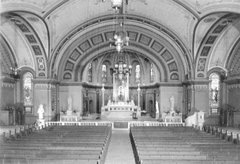Today Fr. Z takes on this very distinction, which turns out to be false.
QUAERITUR: putting collection under the altar during offertory
A reader queries:
Our diocesan liturgist claims that it is ok with Canon law to put the monetary offers under (literally in my parish, there’s an opening under the altar stone, between the supports of the table part) the altar. She says that the GIRM (which I quoted on the subject) does not have the weight of canon law. [FAIL.]
I am pretty sure she’s wrong, [She is wrong.] and you seem like the sort of priest who could point me to where she is wrong. Is there anything written to the effect of GIRM is the law of the Mass, and Canon Law is the law of (whatever Canon Law deals with)?I consulted a canonist just to be sure to get the right language for this fundamental response which any priest or "liturgist" – lay or ordained – ought to know in order to claim anything close to competence.
Canon 2 of the 1983 Code of Canon Law for the Latin Church pretty much destroys the argument of the diocesan liturgist:
"For the most part, the Code does not determine the rites to be observed in the celebration of liturgical actions. Accordingly, liturgical laws which have been in effect hitherto retain their force, except those which may be contrary to the canons of the Code."
This acknowledges several important things – first of all, liturgical law is truly law – not just "guidelines."
Secondly, the Code is not the place to look for liturgical law. The Institutio Generalis Missalis Romani (hereafter GIRM) was duly promulgated as law in accord with canons 7 and 8.
John Huels (a canonist who holds a lot of weight – mostly deservedly – among liturgists – though no weight at all concerning anything else and for pretty serious reasons) states in his book Liturgy and Law:
The major sources of universal liturgical legislation for the Latin Church are the norms contained in the liturgical books, the canons on the liturgy in Book IV of the Code, and other current legislative texts issued by the Holy See. The canons of the Code for the most part do not specify matters dealing directly with the celebration of the liturgy. Such laws are found principally in the liturgical books in two forms: the rubrics and the praenotanda.... Both rubrics and praenotanda are overwhelmingly ecclesiastical, not divine, laws and are subject to the general norms of the Code on ecclesiastical laws. They are equal in weight to the canons of the Code and to other universal ecclesiastical laws. (p. 84 ff)
Article 73 of the GIRM has the same canonical weight as a canon.
Shall we have a look?
The Preparation of the Gifts
73. At the beginning of the Liturgy of the Eucharist the gifts, which will become Christ’s Body and Blood, are brought to the altar.
First, the altar, the Lord’s table, which is the center of the whole Liturgy of the Eucharist,70 is prepared by placing on it the corporal, purificator, Missal, and chalice (unless the chalice is prepared at the credence table).
The offerings are then brought forward. It is praiseworthy for the bread and wine to be presented by the faithful. They are then accepted at an appropriate place by the priest or the deacon and carried to the altar. Even though the faithful no longer bring from their own possessions the bread and wine intended for the liturgy as in the past, nevertheless the rite of carrying up the offerings still retains its force and its spiritual significance.
It is well also that money or other gifts for the poor or for the Church, brought by the faithful or collected in the church, should be received. These are to be put in a suitable place but away from the eucharistic table.
NB: "These are to be put in a suitable place but away from the eucharistic table."
AWAY from the altar.





















No comments:
Post a Comment